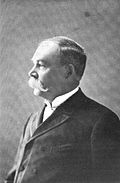Aftermath
After James E. Boyd was declared the winner, his opponent, John H. Powers, disputed the results of the election. While Boyd won by a margin of 1,144 votes, Powers claimed to have evidence that "2000 persons were bribed in Douglas County to vote for Boyd." [7] [8] A resolution to investigate these allegations was introduced in a joint session of the Nebraska Legislature, but it was ruled out of order. [9]
However, the trouble was not over for Boyd. He was due to be sworn in as governor of Nebraska on January 8, 1891, but John Milton Thayer, who was not a candidate in the 1890 election, challenged Boyd's citizenship, and thus his eligibility to be governor. This delayed Boyd's inauguration until January 15. Boyd took office as governor; however, he only served until May 5, 1891, because the Supreme Court of Nebraska ruled that Boyd was ineligible to be governor, and thus Thayer took office again on May 5. [10] [11] Boyd took his case, Boyd v. Nebraska ex rel. Thayer , to the United States Supreme Court, and it was argued on December 8, 1891. [12] On February 1, 1892, the Supreme Court of the United States ruled that Boyd was eligible, and thus he took office again on February 8, 1892, and served out the remainder of his term. [12] [13]
This page is based on this
Wikipedia article Text is available under the
CC BY-SA 4.0 license; additional terms may apply.
Images, videos and audio are available under their respective licenses.




